Specialties
| Prosthodontics is the dental specialty primarily concerned with the restoration and replacement of lost or damaged teeth. Is defined as “the dental specialty pertaining to the diagnosis, treatment planning, rehabilitation and maintenance of oral function, comfort, appearance and health of patients with clinical conditions associated with missing or deficient teeth and oral tissues using biocompatible substitutes.” Prosthodontics is one of the nine dental specialties recognized by the ADA. |
 |
Prosthodontists are experts in the restoration and replacement of teeth, they make smiles look beautiful and function the way they should.
A prosthodontist has three years of extended training in a graduate program in several areas of restorative dentistry, including dental implants, crowns, bridges, complete dentures, partial dentures, esthetics, occlusion, and dental birth defects. Prosthodontists are also trained in the technical and technological aspects of laboratory fabrication of complex dental prosthetics and complex restoration of dental esthetics..
Many like to think of Prosthodontists as the “quarterback” of a dental treatment plan. They regularly lead teams of general dentists and other specialists to develop solutions for your dental needs.
These specialists plan and carry out procedures related to the replacement of natural teeth, in part or in full. Some of these treatments include:
- Porcelain Veneers— wafer-thin shells of ceramic material that cover the front surfaces of teeth, providing a dramatic change in appearance. These are bonded to teeth that have been prepared by having a small amount of enamel removed, so they don’t appear too bulky. Long-lasting veneers can change the size, shape or color of teeth, and even close small gaps between.
- Crowns— artificial covers (sometimes called “caps”) that replace the entire visible surface of a tooth above the gum line. Fabricated of metal, porcelain fused to metal, or metal free (porcelain or zirconia), crowns are cemented to a prepared tooth. They are often needed after a root canal procedure, or to repair fractured, broken or misshapen teeth.
- Dental Implants— when it’s necessary to replace an entire tooth (both roots and crown), this method is considered today’s gold standard. Implants consist of a titanium metal screw which is implanted in the jaw in a minor surgical procedure. This screw becomes fused with the jaw bone, providing a solid anchorage for a lifelike crown. Implants can be used to replace single or multiple teeth, or to support other types of dental restorations, such as bridges or partial/complete dentures. While implant surgery is usually performed by other specialists, prosthodontists often design and place the implant crowns.
- Fixed Bridges— this tooth-replacement method uses the existing, healthy teeth (called abutment teeth) on either side of a gap to support one or more artificial teeth. A series of linked crowns is fabricated as a single unit, which is then attached to the prepared abutment teeth. These work like a roadway-bridge foundation to hold up the crowns for the missing teeth in between. Bridges are a time-tested tooth-replacement method, but require special attention to cleaning, and potentially compromise the structure of the otherwise healthy abutment teeth.
- Dentures– Is a removable replacement for missing teeth and surrounding tissues. Two types of dentures are available, complete an partial dentures, both can be conventional or implant supported. Complete dentures are used when all the teeth are missing, while partial dentures are used when some natural teeth Complete dentures can be either “conventional” or “immediate” made after the teeth have been removed and the gum tissue has begun to heal, a conventional denture is ready for placement in the mouth about eight to 12 weeks after the teeth have been removed.
| Is the study of the specialised system of hard and soft tissues that supports your teeth and mantains their position in the jaws. This important system known as periodontium, has very important functions, such as; it securely attaches the teeth to the jaws; it acts as a shock absorber during biting and chewing and therefore helps to prevent a demage from exccesive forces and it also mantains the teeth in a stable position within the jaws so that they can work together efficiently. |  |
Periodontist are dental prefesionals who specialise in the prevention and treatment of diseases of the tooth-supporting structures. Although all dentist are trained in the diagnosis and treatment of periodontal diseases, it is usual to refer cases that require special treatments to a periodontist, who will have additional training and acquired special expertise in the área.
Dental implants have been used to replace missing teeth since the mid-1960´s but in recent years their use has become much more widespread. They can be used to support crowns replacing single missing teeth, bridges that restore a larger span of missing teeth, or even dentures.
Dental implants are manufactured from titanium, a metal that is known to be compatible with body tissues and able to bond to adjacent bone during a healing process known as osseointegration.
There is evidence that shows that dental implants are a safe and convenient alternative for replacing missing teeth with a natural looking result.
| The overall aim of dentistry or dental practive is to mantaing a healthy mouth and dentition. The aim of endodontic treatment is to preserve functional teeth without perjudice to the health of the patient.
If you are experiencing tooth pain, have injured your tooth, it’s sensitive to hoto r cold, and/or there is swelling around the teeth, gums or your face, make an appointment with an endodontist. |
 |
The scope of endodontology includes, but is not limited to:
- The differential diagnosis and treatment of oro-facial pain of pulpal or periradicular origin.
- Prevention of pulpal and vital pulp therapy.
- Root canal treatment.
- Treatment of post endodontic disease.
- Surgical endodontics.
- Bleaching of endodontically treated teeth.
- Treatment of traumatized teeth.
| The goal of orthodontic treatment is a beautiful smile and a good bite, witch means, straight teeth that mesh well with the teeth in the opposite jaw and look great. A good bite makes it easier for you to bite, chew and speak. Many people find a beautiful smile adds to self-esteem, self confidence and leads toward career advancement. We live in a competitive world and a great smile can give you the adge.
Orthodontic treatment is often part of a comprehensive dental care plan. With good care, including orthodontic treatment when necessary, teeth can last a lifetime. Treatment in children or teenagers who are still growing may yield results that may not be posible once the face and jaws have completed their growth. If you want to know what is ideal treatment for you, contact our orthodoncist and make an evaluation appointment and remember that is always very important to be taken care of by a specialist. |
 |
The oral and maxilofacial surgery is one of the specialties that take care of prevention, study, diagnosis, treatment and rehabilitation the oral patology, face and facial skull aswell as the organs and structures related to them.




